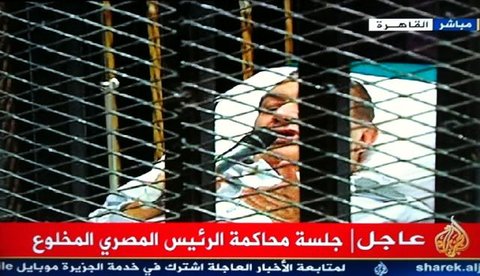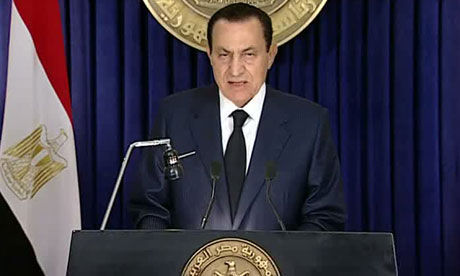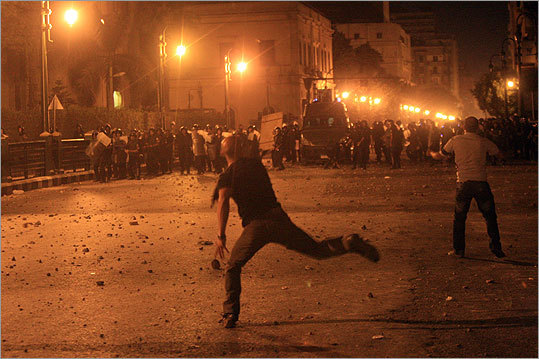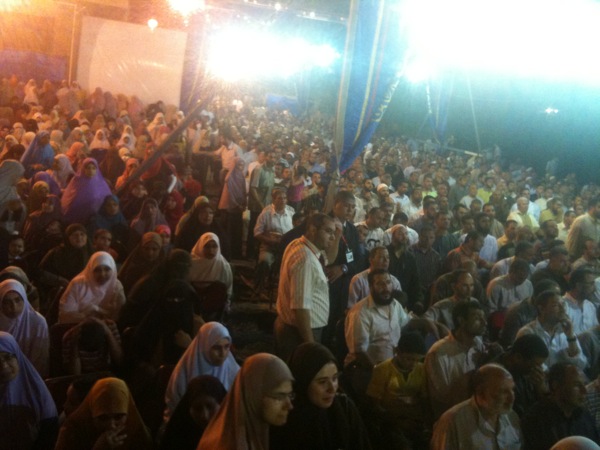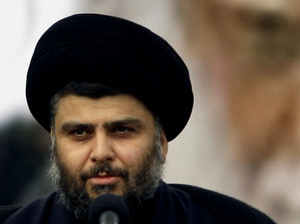Hezbollah after Bashar
BEIRUT, Lebanon — Hezbollah supporters have been watching the turbulence next door in Syria with apprehension. Rhetorically, the Lebanese Party of God has backed its patron in Damascus, although its embrace has grown tepid of late. But Hezbollah was worried enough to shift its weapons caches from Syria into Lebanon, reportedly, and its emissaries have been working behind the scenes to mend relations with Syria’s opposition. At the core of their worry is a sectarian concern: Syria without Bashar al-Assad might be willing to jettison Hezbollah — after all, Syria is a majority Sunni nation, and Hezbollah is a Shia standard-bearer.
“The Islamists who are fighting against Bashar Assad are not going to support us if they take power,” one Hezbollah partisan told me recently in Lebanon. “They might believe in resistance against Israel, but they won’t support our resistance.”
If, or more likely when, Assad’s government finally falls to the uprising that has shaken Syria for more than half a year, its successor will renegotiate Syria’s regional relationships. Assad’s long-time friends and clients have good reason to feel insecure. A more democratic Syria would represent the country’s Sunni majority, which includes a fair number of Islamists. They likely won’t share all the priorities of Assad’s brutal minority regime, whose commitment to secular government conveniently justifies its manic clinging to absolute authority.
A Syria led in part by the Muslim Brotherhood, or by a confederation of anti-Assad forces, would probably continue to support resistance movements that fight Israel, and would likely continue relations with Iran (and, possibly, pursue warmer relations with Iraq). But it might be less vested in the ideological absolutism of the existing “Axis of Resistance,” led by Hezbollah and Iran, and more interested in a new Arab nationalist front, which could unite Egypt, the Palestinians, and other post-dictatorial Arab states in an alliance that opposes Israel and some American projects from a less bellicose footing.
The threat to Hezbollah is tangible, and has broad regional implications.
Hiatus over
I had this notion that I could spend a month taking care of my kids in a city I know well but where I don’t live, without skipping a beat in my workflow. Well, I was grossly wrong. I’ve just finished a most wonderful stretch of time in Lebanon while my wife pitched in on the Times’ Libya coverage, and the score ran conclusively in favor of kids and against work. I managed to meet one deadline, but all other writing and most intellectual activity ground to a halt. That’s why I have hardly been present here, or at The Atlantic online. Now I’m back in Cairo and shortly should return to standard output. First, though, I have to figure out exactly what happened while I wasn’t looking.
Meet the new power players II
How consequential was 9/11? How much of our response was theatrics, how much a lost opportunity, and to what extent is our brain trust doing its job? My column last week about America’s failure to adapt to a world no longer dominated by traditional states has prompted some interesting responses. Dan Drezner at Foreign Policy opens a conversation about my contention that international affairs thinking still hasn’t caught up with a fluid post-Cold War order whose arrival was emphasized by 9/11. One question he raises:
Is it that international relations theory has gone stale… or is it simply that the wrong set of existing theories are in vogue today?
Isn’t is possible that both are the case? Folks like Nye, Walt, and Doyle have been wrong about some big things in the 1990s (like the Democratic Peace; it turns out that democracies, or democratizing nations, do sometimes go to war with each other). And in the 2000s, there was a big idea, Bush’s Freedom Agenda, but it was the wrong idea, and didn’t work.
Roland Paris adds another salient question to the discussion. Is there really a need for a bumper sticker, a grand unifying theory? Or doesn’t a complicated world require complicated thinking? To that I say, of course – but if you don’t have a grand strategy that’s easy to articulate, akin to containment after World War II, then you probably are adrift. Complex ideas that are clear and compelling can be summarized clearly without being reduced to a silly bullet point. Paris also points out some recent thinking I didn’t mention in my column:
… more thinking has taken place on the changing nature of international affairs than Cambanis acknowledges. He mentions the works of Nye, Doyle and Walt, all of whom are great scholars. However, as my former University of Colorado colleague, Dan Drezner, points out, the ideas that Cambanis mentions are not new. Nye’s insights into ‘soft power’ were first published in 1990, for example, while Doyle’s pioneering work on the ‘democratic peace’ appeared in the late 1970s. Drezner could have added that in the ensuing years there has been a flurry of scholarly writing addressing the issues that Cambanis raises– including works about the role of non-state actors and about ‘fuzzier’ problems such as transnational networks and failed states. Admittedly, much of this literature is full of academic jargon, but an interested reader with a bit of perseverance will discover rich veins of gold to mine. (If you are interested in taking up pick and shovel, this course syllabus, which lists some recent writings, is a good place to start. If, however, you prefer to have a shiny nugget handed to you, take a look at this thoughtful article by Princeton’s John Ikenberry.)
It’s possible that the great ideas that will carry us into the future are circulating quietly and will soon hold sway in the salons of power. It’s also possible that America is strategically adrift.
Meet the new power players
EVEN BEFORE WE knew who had committed the attacks of Sept. 11, 2001, it was clear that the event would be transformative, startling Americans into reconsidering how they understood matters from religion and culture to war and civil liberties.
For the nation’s foreign policy brain trust, it announced one thing in particular: A new species of power finally had come of age. The force behind the 9/11 attacks wasn’t an enemy nation but a small band of resourceful zealots scattered around the world. Al Qaeda was what experts call, for lack of a more elegant term, a “non-state actor” – one of a new species of powers that operate outside the umbrella of traditional governments. These powers run the gamut from terrorist cells to Google, from globe-spanning charities to oil conglomerates. As much as anything, the 9/11 strikes illustrated the profound influence that non-state actors could have on world affairs.
You might think that the sudden demonstration of the radical power of a non-state actor would have triggered an equally bold reaction at the highest levels of policy thinking: a coherent shift in grand strategy, in America’s thinking about how it should contend with the wider world, on the scale of the one that developed after World War II.
Surprisingly, though, if there is one thing that 9/11 didn’t change, it was this. Instead of a flurry of new thinking at the highest echelons of the foreign policy establishment, the major decisions of the past two administrations have been generated from the same tool kit of foreign policy ideas that have dominated the world for decades. Washington’s strategic debates – between neoconservatives and liberals, between interventionists and realists – are essentially struggles among ideas and strategies held over from the era when nation-states were the only significant actors on the world stage. As ideas, none of them were designed to deal effectively with a world in which states are grappling with powerful entities that operate beyond their control.
“Great power relations, war, diplomacy, we know how to do that,” says Stephen Krasner, a Stanford University international relations specialist who ran the policy planning department in George W. Bush’s State Department from 2005 to 2007. “We don’t know how to deal with these tricky non-state questions.”
A look at the major foreign crises of the last two decades, the ones that have demanded the most attention, money, and lives from America, reveals that virtually all of them were provoked not by some hostile scheming government in Moscow or Beijing, but by an entity that would have been beneath the radar of a classic global strategist. In the 1990s, warlords in Somalia and Bosnia ripped apart their regions while bedeviling old-line powers like the United States, Britain, and NATO. On the eve of the millennium, the United States struggled to grapple with the fallout from a failed hedge fund, Long-Term Capital Management, and Argentina’s economic collapse – financial crises whose political repercussions outstripped those of many wars. The Sept. 11 attacks only made obvious a change that had already been apparent to many.
Ten years later, we are still waiting for the intellectual response to that change. And already we can see the costs of its absence. The United States responded to the 9/11 attacks with strategies that made sense in the old days of state-vs-state conflict, deploying the world’s most powerful armed forces and spending more than $1 trillion trying to subdue bands of simply trained and lightly armed men in Afghanistan and Iraq. Many strategists see a rising China as the next major threat in a traditional sense, but even China’s challenge to American interests is largely taking place outside traditional state channels: in contests for oil concessions, and struggles for high-tech revenue, cultural influence, and intellectual property. The cost of getting these types of struggles wrong can, in the long term, be even greater than a runaway war.
Inside Egypt’s Military Mind
CAIRO, Egypt — Retired Egyptian Army General Hosam Sowilam knows how to control a conversation. With a jocular smile and a booming voice, he’ll hold and repeat a phrase — “Chaos! Chaos! Chaos!” — until he’s drowned out the question he doesn’t care to answer, dispelling even the shadow of doubt as he regains the floor.
“What happened on January 25?” Sowilam bellowed by way of introducing his history of the uprising in Tahrir Square. “Many of our youths went to Serbia and the United States of America, where they received training in how to overthrow the regime. They received training from Freedom House, and funding from the Jewish millionaire Soros.”
He goes on to weave a detailed story of a foreign plot against Egypt, in which unscrupulous agents from America, Israel, Saudi Arabia, and Qatar, backed by a web of corporate interests, took advantage of Egyptians legitimately dissatisfied about Hosni Mubarak’s plan to transfer power to his son.
“Look!” he says, pointing in a bond dossier at a page of logos from companies like Edelman and CBS. “All these corporations were behind the Arab spring. This is very dangerous.” There are headlines about Soros from websites like truthistreason.net and AnarchitexT.org (“I don’t know any thing about them,” Sowilam says. “I found them on the internet.”) Other data comes from better-known sources like The Washington Post and Wikileaks. He has carefully translated key points into Arabic to share with Egyptian reporters.
Although Sowilam holds no official role in the army that governs Egypt today, he considers that army his life, and relishes any chance to speak for its values and mindset, if not its official policies. He remains close to senior officers, and had a second career after the military at a defense think tank and now as an unofficial spokesman for the military. (I first met him a year ago while reporting a story about the military’s view on then-President Mubarak’s succession plans; Sowilam adamantly criticized the notion of hereditary power, but also warned that the military never would permit Islamists to rule Egypt.)
Bald and squat, with a body shaped like a calzone, Sowilam has the typical build of an artilleryman. An early career surrounded by the thud of big guns marred his hearing, which is why he often shouts in casual conversation. Born in 1937, Sowilam came of age and attended the military academy in the 1950s, in the halcyon era of Gamal Abdel Nasser’s Free Officers revolt. He took his commission when the army was at the zenith of its power, boldly refashioning Egypt’s political and economic order. He fought in the humiliating defeat of 1967, which he directly attributed to the Free Officers’ “disastrous experiment” with running the country. He later served abroad, including a stint as military attaché in India.
Libyans celebrate in Cairo
A trio of wounded Libyan rebels hobbled down the street, one wearing an eyepatch, another lurching on his crutches. A woman wearing a full niqab had pinned a Libyan flag to her face. Exiled Libyan activists – many of whom had fled Tripoli just months earlier – rejoiced at the news of the capture of two of Qaddhafi’s sons. It was a few hours before dawn on Monday, and a few thousand Libyans had surrounded their embassy in Cairo to celebrate the fall of Tripoli, joined by a smattering of Egyptians.
Rakha Dahan, a 28-year-old make-up artist, had gotten a phone call from her mother in Tripoli informing her that rebels had reached their neighborhood. She rushed out with her infant daughter, but not before applying copious amounts of gold glitter to her cheeks. Dahan’s three brothers are fighting in Libya, as is her husband. Her father is working with the rebels in the western mountains. “We are a crazy family,” she said. “You can imagine how my mother feels.”
Fireworks and bottle rockets made deafening noise in the narrow streets of Zamalek around the embassy. Egyptian riot police formed a cordon, but dissipated when they realized the demonstrators had no intention of storming the building.
Usama Mahfouz Al-Saha, a prosecutor from Tripoli, strode over to think a trio of Egyptian activists. “Without you, we never would have made it,” he said, shaking their hands warmly. “The revolutions in Tunis and Egypt gave us the push, the feeling that we can do the same and have change in our country.”
One of the Egyptians, Amr Shebl, was beside himself; he’d been checking Twitter, watching television and updating his Facebook feed all night to get his fix of Libya news. “The smell of freedom is awesome,” he said. “I’m having the same feeling I had the day Mubarak stepped down.”
Al-Saha, the Libyan prosecutor, exuded satisfaction but also worry. He said he had planned anti-Qaddhafi demonstrations early in the uprising, and had fled to Egypt with his family when a friend in government warned him his arrest was imminent.
The tribal rivalary unleashed during the civil war could persist, Al-Saha said, but most of all he feared the bitter disputes that will begin after Qaddhafi is gone and Libyans try to reclaim property seized over the last 42 years by the state or by Qaddhafi loyalists. “This will cause chaos in the country,” Al-Saha said, as his fellow Libyans chanted and danced around him. “It will take years to sort out.”
Revolution AM Boston
A chat from a few weeks back with Jeff Santos about Egypt and the regional context; audio file just posted here.
Egypt: Now What? (in The Guardian)
Youth activists Moaz Abd El-Kareem, Sally Moore and Mohammed Abbas. Photo: Platon (Human Rights Watch)
On a sweltering night shortly before the start of Ramadan, the Muslim Brotherhood convened a political rally in the Nile Delta town of Shibin El-Kom. Most Cairenes wouldn’t even drive through the capital of Monufiaprovince unless they had family there. Agriculture is the only business in this marshy area at the start of the maze of canals and river branches that marks Egypt‘s breadbasket. The peasants, or fellaheen, who till the land are religious, nationalistic and socially conservative. The elites who rule Egypt have their roots in such places – the previous two presidents, Hosni Mubarak and Anwar Sadat, were born in Monufia – but once in power dismiss them as backwaters. Among the nation’s power players, though, the Muslim Brothers are an exception; their leadership comes largely from the educated working classes and boasts an easy familiarity with the fellaheen.
The rally in Shibin El-Kom officially launched the parliamentary election campaign of the Muslim Brotherhood’s new political wing, the Freedom And Justice party. Informally, the Islamists were striving to distinguish themselves from the revolutionaries who had upended the country’s crusty political order in January and who were again occupying Tahrir Square – and naming the Muslim Brotherhood among their counter-revolutionary enemies. Activists had set up a utopian tent city in Cairo’s central plaza, trumpeting their vision for a civil state and decrying the fact that half a year after Mubarak’s resignation the nation was still governed by a military dictatorship. After a month in the square, however, they were drawing fewer people every day, their message drowning in a stream of dictates from an increasingly nasty Military Council and criticism from increasingly acerbic Islamists.
The scene couldn’t have looked more different in the Delta. The Brotherhood had selected for its rally a dirt track off the town’s main bypass. Several thousand people, mostly professionals, merchants or farmers, came with their families; volunteers were encouraged to donate blood at ambulances. On stage, party leaders paid tribute to the local families of the martyrs of the revolution – protesters killed in January and February – then moved on to business. A women’s committee chief outlined the jobs women held in the party; a farmer spoke about its agricultural cooperatives. Finally, party head Mohammed Morsy gave a rousing speech. “The people gave their revolution to the military to protect,” he thundered. “The only legitimacy in this country today comes from the people.” In closing, he ordered his audience to demonstrate the party’s discipline and breadth in their neighbourhoods – by picking up the garbage.
Six months after Mubarak surrendered to millions of Egyptians, the same generals still rule. Arbitrary detention and allegations of torture are commonplace, if less widespread than before. State media still demonises critics of the junta, and the military – without public consultation – will decide exactly what process is supposed to lead to democratic elections and a civilian government. Reformers and revolutionaries fear the military, stronger now than under Mubarak, will outmanoeuvre them. And they fear Islamists will sweep the elections and control the writing of a new constitution, leading to a democratic Egypt that’s neither secular nor liberal.
In short, the problem is this: idealistic revolutionaries dream of an Arab democracy that reflects popular values but opens its arms to Muslims, Christians and people who want a secular state. But they look outgunned by the religious right, which wants majority rule, and whose force was apparent on the last Friday in July when a million people flooded Tahrir Square demanding “Islamic state, not civil”. Above the fray, the generals rejoiced: the more profound the divisions between Islamist and secular opposition, the better for them.
The summertime scenes in Tahrir Square belie the sense that the revolution is increasingly marginalised and under threat. At its core, the revolution represents a force that is much more willing to criticise authority, and tolerate diversity, than perhaps mainstream public opinion. The original throngs that fought riot police drew on at least three major and messily overlapping constituencies. First were the activists – organisers of all political and religious stripes who had come to trust each other over years of strikes, tiny protests and mass arrests. Second were the politicised people previously afraid to challenge the regime but who brought to the protests a distinct agenda – labour unionists, socialists, liberal NGO workers and more conservative religious activists. Finally, there were the hundreds of thousands of angry and apolitical Egyptians sick of Mubarak’s police state.
Outgunned Liberals Stump in Rural Egypt
KAFR EL-SHEIKH, Egypt — Bassem Kamel was running late for the official launch of the Egyptian Social Democratic Party in this provincial capital at the marshy edge of the Nile Delta.
Kamel is a busy man. He sits on the executive committee of the Revolutionary Youth Coalition, the most important forum representing the organizations that sparked Egypt’s January 25 uprising. He’s a key organizer of Mohammed El-Baradei’s presidential campaign. And he’s a founder, and likely parliamentary candidate, for the Social Democratic Party, one of the most compelling of the new parties that can credibly lay claim to the liberal Revolutionary political center.
On this summer night, however, Kamel’s top priority was this remote farming entrepôt near the Mediterranean coast, where his party hopes to challenge the better-established Islamist parties in the upcoming elections with a message of equality, social justice, and prosperity delivered by a transparent, liberal, civilian-controlled, secular state.
If liberals are to have any traction in Egypt after Mubarak, they’re going to have to win a following in neglected but not forgotten towns like this one. They’re not shirking from the challenge, and contrary to some caricatures of the revolutionaries here, they haven’t obsessed with the politics of protest and they symbolism of Tahrir Square to the exclusion of other political avenues. How well they’re doing is another matter, and a crucial one for judging the chances of liberalism in Egypt’s next stage.
Islamists always seem to outgun liberals in the contest for mass support, routinely drawing thousands to their rallies, and relying on existing networks of mosques and charities that long pre-date Hosni Mubarak’s resignation.
The Social Democrats, by contrast, operate on a shoestring and are starting from zero. Kamel and the other founders have drafted a careful platform that adapts the vision of Europe’s social democrats to Egypt’s vast population, endemic poverty, and state-dominated economy. Put simply, the Social Democrats want to help the poor without stifling the market; they want to create wealth as well as redistribute it. Add to the mix a deep respect for pluralism, religious freedom and individual liberties, and you’ve got a potent – if not yet popular – liberal brew.
Egypt on “To the Point”
Warren Olney did a long segment yesterday on Egypt, talking with Mona Eltahawy and me. You can listen here.
Non-violence vs. Violence
There’s been some interesting criticism of my piece in The Boston Globe on Sunday about the increasing calls for violence among revolutionaries in Egypt. The best-known scholars of nonviolence, whose research I cite in my column, take exception to my analysis and raise some valid objections to the way I framed some of the other research. Other writers have gone further, accusing me of advocating violence. Briefly: the question is not whether nonviolent revolt is preferable – of course it is, and when successful it leads to more liberal, stable political transitions than violent revolt. The pertinent question is, in what situations are nonviolent revolts doomed to fail? And against recalcitrant regimes that will use all possible force to suppress dissent, what avenues are open to the revolutionary? In short, what works against the most oppressive and violent regimes? This inquiry is more topical than ever today, as revolts have failed, are fizzling, or are headed toward full-scale war in countries including China, Iran, Syria, Yemen and Libya. It’s not a question of averages (what works most of the time?), but one of specifics – what works against the most brutal states?
Scholars Erica Chenoweth and Maria Stephan have studied more than a century of uprisings and found that nonviolence is twice as likely to succeed as violence. In a post on Rational Insurgent, Chenoweth says I misread the literature. She’s right that I somewhat sloppily described the work of Robert Pape and Ivan Arreguín-Toft; their research argues that violence works and makes strategic sense, but doesn’t explicitly compare it to nonviolence. I know that Chenowith and Stephan’s work followed the research of Pape and Arreguín-Toft, but the Globe essay makes it sound the other way around. Chenowith goes on to write:
Contrary to Cambanis’s argument, the historical record reveals rather dramatically that nonviolent resistance is strategically superior, and, in the end, often leads to much more democratic and stable societies than violent insurgency. Although Egyptians may be rightly frustrated with the pace and direction of the transition, they need only look to other recent cases—such as Libya or Yemen—to see the risks of using violence to attempt to improve their strategic positions. Our research indicates that if Egyptians resort to violence, their chances of success will drop by about half, the risk of civil war will steeply rise, and the chances for democracy in the foreseeable future will be considerably reduced.
Other writers take up a related form of argument. Tom H. Hastings writes that nonviolence is more likely to overturn a repressive government than violent revolt, which might well replace one tyranny with another. I think he has a good point, and I personally don’t think a violent revolt in Egypt is more likely than a peaceful one to lead to a liberal state; nowhere in my Globe piece do I make this contention. Hastings also nastily suggests that I must be a fan of mass killings in the name of revolution, a pointless and unfounded slander which merits no response but says something about the low standards to which people hold themselves in public writing these days.
Eric Stoner asks whether The Boston Globe “would prefer violence in Egypt.” Speaking for myself, again, I would not. But I’m a journalist, not an ideologue, so I’m asking questions like what actually works, and what is actually happening. If frustrated Egyptians start taking out hits on police officers, it won’t be because of my column. And if Egypt’s admirable nonviolent revolutionaries manage finally to push the ruling military out of power and install an elected, accountable, civilian government in its place, without widespread violence, it won’t be because of our essays. Although it will be an outcome to cheer.
The genesis of my Globe essay was entirely organic. In more than a dozen interviews, Egyptian activists told me without my even raising the subject that they were considering adopting violent resistance (mostly vigilante killings of police officers who had killed civilians) because non-violent protest hadn’t accomplished as much as they would like. This widespread organic sentiment prompted me to explore the idea as a story. None of the strategic organizers of the protests in Tahrir Square advocated a turn to violence, although several of them told me that they thought some limited violence might prompt further concessions from the military junta presently ruling Egypt.
The phenomenon of arguing for violence led me to history and political science. Historically, had successful revolutions employed violence? And what had political scientists found?
The record, of course, is mixed. The French Revolution became increasingly violent and radical, and of course, led to a backlash and an illiberal century. The Russian Revolution began comparatively peacefully, toppled the czar, and then was overtaken by a violent Bolshevik coup that created a brutal police state. Eastern Europe in the late twentieth century offered up a cast of “Velvet Revolutions,” in which violent states were quickly overturned by peaceful protest.
A few scholars I contacted offered very thoughtful comments that were sadly edited out of the published piece for length.
Mark Kramer, director of the Project on Cold War Studies at Harvard’s Davis Center for Russian and Eurasian Studies, said that proponents of violence often misunderstood the legacy of the Russian Revolution.
First of all, the real Russian Revolution was in March 1917, and it was peaceful. The Tsar’s regime collapsed in the face of escalating protests and mutinies in the army, and a new, democratic government (the provisional government headed by Aleksandr Kerensky) came to power. What happened in November 1917, when the Bolsheviks seized power, was really a coup d’etat and not a revolution. … The real revolution (in March 1917 with the overthrow of the Tsar’s regime) was a good case in which peaceful protests worked. The Bolsheviks’ subsequent willingness to rely on mass violent terror to seize power was a disaster for Russia. I have no doubt at all that Russia would be a much better country nowadays if it had not been forced to endure seven decades of rule under one of the most violent dictatorships that ever existed.
About the research of Chenoweth and Stephan he says:
I find their argument very intriguing, but one clear problem is that their database unavoidably omits countless non-violent resistance campaigns that never begin (because they are deterred) or that are crushed at a very early stage before they become widely known. Hence, the database is biased toward successful cases of non-violence, leaving ample room for debate about the authors’ conclusions. Moreover, even if Stephan and Chenoweth are correct in their aggregate analysis of non-violent resistance campaigns unadjusted for size, the existence of crucial outliers — China in June 1989, Burma in 2007, Zimbabwe in 2005 and 2008, and Iran in June-July 2009 — raises further questions about the validity of their argument. Suffice to say that more research will be needed.
For now, the question of whether the use of violence by a protest movement is likely to contribute to the ouster of a regime remains open. The downfall of regimes in numerous countries after non-violent protests over the past 35 years, most recently this year in the Arab world, is extremely important to bear in mind, but in many instances, including China, Uzbekistan, Burma, Zimbabwe, Iran, and Belarus among others, autocratic governments have been willing to rely on ruthless violence to crush mass non-violent protests and prevent further challenges.
On the other hand, the inefficacy of non-violence in many cases does not necessarily mean that the use of violence would have been more conducive to success. Clearly in some cases the use of violence has simply made things worse. The Chechens’ resumption of violent attacks in August 1999, rather than proceeding with non-violent negotiations to settle the final status of Chechnya as called for under the August 1996 Khasavyurt accords, ended what was arguably the best chance Chechnya has ever had (or will ever have) to achieve independence. The Chechen guerrillas’ decision to resort to violence proved disastrous.
Personally, I don’t advocate violence, torture, or extrajudicial killing, whether by states or insurgents. It’s still worth asking though – and the research of Chenowith and Stephan in no way ends the debate – whether nonviolent protest works against a regime truly determined to stay in power at all costs (cf. China, Iran, Syria, and Libya).
Mubarak on Trial
Lots of good copy out of Cairo on the opening day of Mubarak’s trial. What a sight! The indispensible leader on a hospital bed, in a cage, flanked by his sons and six of his top cops. Anthony Shadid captures the scene gracefully (and his set-up piece is also worth reading).
WNYC’s The Takeaway had me on this morning to talk about the trial; you can listen here.
UPDATE:
WBUR’s Here & Now talked to Mahmoud Salem (author of the Sandmonkey blog) and then me at noon Eastern time, mainly about the prospect and peril of Egypt’s revolution turning to violence.
Mubarak Trial: Justice or Revenge?
Hosni Mubarak liked to imply that he united otherwise ungovernable Egyptians under his rule by sheer force of will. As he makes his debut in the defendant’s cage on Wednesday (a barbaric if quite photogenic tradition of the Egyptian justice system), he is bringing together a fractious coalition of Egyptians but not in the manner he intended: baying for his blood.
The most important question, though, isn’t whether Mubarak pays for his past deeds with his life, but how he pays, and for which of his regime’s alleged misdeeds.
A surprising number of people across the spectrum of class and political persuasion told me they’d like to see the dirtiest laundry of Mubarak’s reign aired at trial, followed by a cathartic public execution.
“I want him to hang in Tahrir Square,” a car parts dealer in the Cairo neighborhood of Boulaq told me, adding something blush-worthy about what he’d do to Mubarak if he could get his hands on the former president, which ended with the phrase “I’d make him my bride.”
With more sophisticated language, the revolutionary groups that until recently occupied Tahrir Square have made justice for Mubarak a central demand. Even the military presently ruling Egypt seems to have decided to cast its former chief to the wolves. The judiciary, some of whose key members owe their positions to Mubarak, have expediently and belatedly lent their support to a quick, public trial, perhaps realizing it is the key to their own future viability.
Families of martyrs circulate Tahrir Square demanding an accounting of their missing relatives, like Sayed Goma, 52, who has carried a portrait of his missing teenage son around his neck for the last six months. Nearly crazed with grief, Goma has quit his job as a driver, and talks incessantly of vengeance. “I want them all to go to hell,” he says of Mubarak and his entire ruling apparatus.
But this most unifying demand – that Mubarak be tried for the deaths of 846 or more Egyptians during the uprising that began on January 25 – avoids a reckoning of three decades of complex, nefarious and corrupt authoritarian misrule. A thorough accounting of the Mubarak era would require investigations and likely prosecutions for rampant torture, extrajudicial detention, manipulation of elections, state-sanctioned distortion, blackmail and infiltration of civic institutions ranging from universities and labor unions to professional syndicates and religious organizations. Then there’s the nearly ubiquitous corruption of economic life, in which the first-hand role of Mubarak’s family and inner-circle would barely amount to a prologue.
A sound and thorough judicial inquiry into all these abuses might take years, and certainly would require a renaissance in Egypt’s legal system, which still enjoys wide respect but has been tarnished by decades of crony appointments and arbitrary laws issued by Mubarak and regularly whitewashed by some quarters of the judiciary. It also would require the presumption of innocence for Mubarak, and at least the possibility of guilt for others, including senior military officers, currently enjoying full freedom.
How Mubarak is tried is just as important as what he is tried for. If the former president is charged only for the killing of demonstrators in 2011, or for the illegal enrichment of his nuclear family, the proceedings will tacitly condone the authoritarian system that Mubarak built and the excesses it promoted. Similarly, if the judicial process reeks of vengeance (or to the contrary, if it gives the former president a free pass), it will fail to pave the way toward a new standard of rule of law in Egypt.
A Call to Arms
[Read the original in The Boston Globe.]
CAIRO – When Egyptian president Hosni Mubarak resigned after 18 days of public demonstrations here last winter, Tahrir Square instantly took its place in the world’s iconography of peaceful protest. Young men and women brandishing nothing more lethal than shoes and placards had toppled a dictator. One subversive slogan – “The people want the fall of the regime” – in the mouths of a million people overpowered a merciless police state.
That was half a year ago. Today, Mubarak’s military council runs the country, wielding even more power than before when it had to share authority with the president’s family and civilian inner circle. The military has detained thousands of people after secret trials, accused protesters of sedition, and issued only opaque directives about the country’s path toward a constitution and a new elected civilian government.
As time passes and revolutionary momentum fades in the broader public, a new current of thought is arising among the protesters who still occupy Tahrir Square, demanding civilian rule and accountability for former regime figures. Many are now asking an unsettling question: What if nonviolence isn’t the solution? What if it’s the problem?
“We have not yet had a true revolution,” said Ayman Abouzaid, a 25-year-old cardiologist who has taken part in every stage of the revolution so far. At the start, Abouzaid wholeheartedly embraced nonviolence, but now believes that only armed vigilante attacks will force the regime to purge the secret police and other operatives who still retain their jobs from the Mubarak era. “We need to take our rights with our own hands,” he says.
Among the dedicated core of Egyptian street activists who have been at the forefront of the protests since the beginning, an increasing number have begun to argue that a regime steeped in violence will respond only to force. Egypt’s revolution appeared nonviolent, they argue, only because it wasn’t a revolution at all: it was a quiet military coup that followed the resignation of the president. They cast a glance at nearby Syria and Libya, still racked by sustained violent revolts against their authoritarian leaders, and wonder if that may be what a true revolution looks like.
Leftist political thinkers have turned to the history of the French and Russian Revolutions to argue that a full break from Egypt’s authoritarian past will ultimately require the use of force against the regime. Rank-and-file activists in Tahrir Square invoke a more visceral rule of power, pointing out that riot troops and secret police agents will yield only to the raw strength of popular confrontation.
Egypt’s trajectory is also raising a bigger question about revolutions: Is the modern view of regime change naive and inaccurate, reading too much into the uprisings that swept Eastern Europe after the fall of the Soviet Union? Perhaps these swift and largely peaceful overthrows of former Communist regimes are the exception rather than the rule when it comes to revolution. And if that’s true, Egypt and the other countries driving the Arab Awakening might be heading not toward something better, but something worse.
Nonviolence was philosophically at the heart of Egypt’s revolution since the beginning, and it’s part of why Tahrir Square appealed not only to millions of Egyptians but to so many in the West. January 25 fit nicely on a bumper sticker, signifying a gentle, acceptable kind of popular uprising for the modern age.
But some in Egypt – even among those who don’t want to see a more violent turn now – are already saying we need to see last winter’s events differently. The days that led to Mubarak’s fall were starkly violent, they point out, and the youth who battled their way into Tahrir Square in January did so by overpowering riot police with rocks and Molotov cocktails.
“We did use violence, but we never started violence,” says Alaa Abd El Fattah, an influential labor activist and blogger who has been organizing teach-ins and impromptu conferences on his country’s future. He has pushed a less utopian narrative of the revolution’s origins, although he still believes that protesters today need to remain nonviolent to achieve their goals.
Recent events, however, have convinced some revolutionaries to feel otherwise. Since Mubarak resigned in February, the military has taken charge of internal security and run the show with the same caprice and impunity that characterized the reign of Mubarak’s secret police. Little headway has been made on the demand that unifies protesters and the Egyptian public – that police officers who killed or abused civilians under the old regime be removed from their jobs and held accountable. Egyptian citizens who express political dissent are still routinely denounced on state-run television as foreign agents and spies. And on June 28, the riot police deployed for the first time since Mubarak left office, and with apparent relish pummeled demonstrators with tear gas, birdshot, and plastic bullets. YouTube videos capture police in and out of uniform taunting demonstrators with swords and sarcastically chanting one of the uprising’s own slogans back to them: “Raise your head, you’re Egyptian.”
Since then, a persistent chorus has started to call for a more violent challenge to the regime’s behavior. Core activists in Tahrir Square point out that it was the brute force of people fighting riot police in January that startled the regime and forced Mubarak’s resignation; they argue that the mostly peaceful manifestations since then have allowed the military dictatorship to survive intact. During the initial uprising, Abouzaid, the cardiologist, slept in front of Egyptian Army tanks to stop them advancing into Tahrir Square. In the past month he has come to embrace an even more radical approach. “Freedom means death,” Abouzaid said. “That is the equation of a true revolution. You know the police officer who killed your son? You go and kill him.”
Families of those killed in the initial uprising have organized a major pressure campaign to force the government account for the missing and put on trial all the officials involved in attacking demonstrators. Otherwise, they say, they will have every right to take justice into their own hands.
“I want them all to go to hell,” says Sayed Goma, 52, who has been wandering through Tahrir Square since January with a picture of his son, who disappeared in the Jan. 28 clashes with police and is presumed dead. Goma blames the government coroner he accuses of burying unidentified bodies of slain protesters in secret mass graves.
“I will kill his son and not give him the body,” Goma says.
Some street-fight veterans talk of assaulting police stations. Others, including some leaders, say that targeted assassinations of murderous police would spur the regime into action.
The pressure to escalate resistance and employ violence has driven a rift through the disparate coalition of groups still occupying Tahrir Square. Leaders of the April 6 movement, a driving force behind the revolution that commands deep support in working-class areas because of its history of labor activism, have studiously shut down any talk of violent action. April 6 has embraced mainstream positions, even tempering criticism of the military junta while generals were accusing the movement of subversion. But rank-and-file members of the group in Egypt, like Joe Gabra, chafe: “We need to take up arms,” says Gabra, a young organizer. “If you get shot at, this peaceful stuff doesn’t work.”
Even Abd El Fattah, the labor activist and blogger who argues against a revolutionary embrace of violence, muses publicly about using it. “I talk about killing police officers all the time. It’s a fantasy,” he says. “It could solve our problems, but it doesn’t mean I am planning to do it.”
The argument in Tahrir Square is more than a local debate over tactics; it reflects a real divide among political thinkers over what works best when challenging a police state. Though revolutions have long been associated with bloodshed, the astonishing success of the “soft” revolutions of Poland, Czechoslovakia, and later the Ukraine drove much policy and social science research in the post-Cold War era. An influential study published in 2008 made a strong case that peaceful protest was the most effective way to challenge authoritarian regimes. In “Why Civil Resistance Works: The Strategic Logic of Nonviolent Conflict,” Maria J. Stephan and Erica Chenoweth studied 323 resistance campaigns from 1900 to 2006, and concluded that nonviolent efforts succeeded twice as often as violent ones. Violent crackdowns on peaceful protesters tended to backfire, Stephan and Chenoweth argued, and nonviolent resistance garnered greater international support.
This line of thinking has apparently been compelling not only to academics but to authoritarian rulers in places like China and Russia, who have deployed the full force of the state against even tiny, marginal civil disobedience campaigns, unnerved at the prospect that they might swell into massive nonviolent uprisings. And the philosophy of the Eastern European “velvet” or “color” revolutions infused some of the drivers of the Arab Awakening itself: April 6 leaders even traveled to Europe to meet leaders of Otpor, the nonviolent Serbian movement that overthrew Slobodan Milosevic.
But these gentle revolutions, it turns out, might be exceptions rather than the rule. There’s a backlash among some historians and political scientists that echoes the gut feeling of Egypt’s frustrated revolutionaries. They suggest, sometimes reluctantly, that regimes that insist on ruling by the gun, so to speak, might only be pushed aside by the gun.
Robert Pape, a University of Chicago political scientist, studied terrorist attacks, aerial bombing, and other forms of coercion, and concluded that violence achieves strategic goals far more effectively than peaceful means. Ivan Arreguín-Toft, a political scientist at Boston University, makes a similar argument about the critical role of violence for opposition movements in his book “How the Weak Win Wars: A Theory of Asymmetric Conflict.”
Some analysts and academics seeking to understand the forces at play in the Arab Awakening look less to the gentle power transitions in contemporary Europe than to the fiery, radical and violent regime changes in Iran in 1979 and France in 1789. These scholars say that the French Revolution, with its guillotine and counterrevolutionary backlash, might be a more useful example of a true break with the past than the measured transitions two centuries later in Eastern Europe. The French Revolution swept aside an entire system, not only removing the royal family from power but smashing the feudal economy and the monarchical philosophy on which it was built. Arab activists have also noted that Iran’s revolution – whose theocratic aims they do not share – successfully remade the entire state because it brooked no dissent and warmly embraced violent tactics.
The gentler Eastern European uprisings, by contrast, are now seen as a different kind of regime change: not so much revolutions as restorations, a return to a broader European trajectory interrupted by Soviet domination at the end of World War II. Other uprisings, like the “people power” waves that overthrew dictators in the Philippines and Indonesia, largely avoided violence because they demanded incremental reform rather than the toppling of an entire system, and the military didn’t defend the regime. It is usually when the dictator’s ruling apparatus refuses any compromise at all that reformist opposition morphs into violent revolution – as is the case today in Syria, where rebellion is veering toward open conflict, and Libya, fully in the throes of civil war. Most Egyptians, it is clear from the public conversation here, would prefer the smoother kind of transition: a revolution without the sturm und drang. The question is whether that will be enough to unseat the military.
Theda Skocpol, the Harvard sociologist who redefined the study of comparative revolutions, cautioned that “there is no one ‘paradigm’ for a revolution.”
“Egypt seems to me to be going through a kind of political change, but not a full-blown revolution,” Skocpol says. With the army still in charge, she argues, nonviolent protests may yet be the most effective approach, especially since the military establishment, which depends on US support, will be sensitive to international public opinion.
Back in Tahrir Square, conversations are rife with historical analogies, as activists trade theories about revolutions past, in France, Russia, and Eastern Europe, and ongoing fights elsewhere in the Arab world.
“We need patience,” Sayed Radwan, a 52-year-old airline counter representative, said on a recent afternoon. “The French Revolution took 30 years.”
“Yes,” snapped his friend, “but first, they killed all the leaders.”
Judging by the size of the crowd…
… Egypt’s secular liberals are in trouble. I have a lot of reporting on the subject to sift through, but a few weeks of immersion in the burgeoning political party scene here suggest that the new liberal parties have a lot of catching up to do. Perhaps a prohibitive amount.
Above is the crowd at the founding meeting of the Egyptian Social Democratic Party in Kafr El Sheikh, a provincial city in the Nile Delta, earlier this month. It numbered fewer than 200, probably closer to 100 by the end.
Below is a rally last night organized in another Delta city, Shibin El Kom, by the Muslim Brotherhood’s Freedom and Justice Party. The crowd numbered about 2,000, all of whom listened rapt until the end of the three-hour event, replete with detailed policy plans and instructions for cadres. If these number are any indication (and some smart people say they’re not), the Brotherhood is running far stronger than anyone else.
NPR: Sadrists follow Hezbollah
Kelly McEvers has a story on NPR about Moqtada Sadr’s methods; he seems to be borrowing directly from Hezbollah’s playbook, and I discuss in an interview with Kelly all the potential for power and long-term pitfalls Hezbollah’s approach entails.
At a recent press conference, Iraq’s minister of planning, Ali Youssef al-Shukri, stepped to the podium, gave a brief and somber blessing, and announced the issue of the day: a new mechanism for quality control of imports to Iraq.
Shukri spoke softly and wore a pressed suit. The former academic has spent time in the United States, on a State Department program for international leaders. One could hardly guess that he belongs to the party of Muqtada al-Sadr, the Shiite cleric best known for fierce battles against U.S. troops during the war and violent threats against the American presence in Iraq that continue today.
Analysts say the planning minister is the new face of Sadr’s party, which now holds 40 out of 325 seats in Iraq’s Parliament. They say Sadr is following in the footsteps of other Islamist groups in the region — namely, Lebanon’s Hezbollah.
Remaking a militant group’s image starts with recruiting middle-class technocrats into the party’s ranks, says Thanassis Cambanis, author of A Privilege to Die: Inside Hezbollah’s Legions and Their Endless War Against Israel.
With Hezbollah, “militants, fighters and ideologues who were leading the party would be happy to assign an obscure dentist or biochemical professor to an important portfolio in Parliament or in the government — if that person could do a better job,” he says. “This lack of ego was a big part of their success.”
It’s a success Cambanis says Sadr hopes to copy. If, say, Iraq’s Planning Ministry can show it’s combating corruption by controlling imports, then the people will continue voting for Sadr’s party.
Egyptian Doctor on Hunger Strike

Dr. Ayman Abouzaid hospitalized in Sharm El Sheikh, where he demands a floor all to himself like Hosni Mubarak. Photo courtesy of Ayman Abouzaid.
Crazy times call for crazy gestures, and Ayman Abouzaid has found himself playing an increasingly high-risk game of chicken with the Egyptian regime. The young cardiologist jumped out of his apolitical cocoon right into the roiling waters of revolution in January. When he wasn’t on call at the Qasr Ayni hospital, he spent his nights sleeping under the treads of Egyptian army tanks to prevent them moving into Tahrir Square.
That sentiment kept him on the streets for weeks then, and kept him shouting and railing about all the enduring injustices of his system, from the impunity still enjoyed by Hosni Mubarak’s coterie to the petty corruption that he says allowed supervisors at Qasr Ayni to falsify autopsy results on protesters murdered by the police.
Ayman Abouzaid’s rage might yet make him a bellwether of where Egypt’s revolution is headed now.
At 25, he had given up on a future in Egypt and was looking to continue his medical training in Germany. But the revolution watered anew his love for country. When I first met him, arrayed with a few dozen men beneath a tank by the Egyptian Museum, he was nearly euphoric. It was a few days before Mubarak acceded to people power and resigned, but Abouzaid already was convinced it would happen.
“The people here will only leave in two situations,” he told me. “When Hosni Mubarak and the National Democratic Party are judged and executed, or we all have to be dead.”
Hezbollah’s Legitimacy Under Threat
Just a year ago, Hezbollah was sitting pretty. Lebanon’s Party of God had consolidated its influence across the Arab world with a durable set of alliances. Its Axis of Resistance, formed with Iran, Syria and Hamas, had emerged as the most credible and authoritative force in Middle Eastern politics. Its central idea—to mobilize self-reliant communities around a frontal confrontation with Israel—seemed to be setting the region’s agenda.
But the Arab Spring changed the rules of the game that Hezbollah so masterfully played for the last two decades. Today, the party faces perhaps the biggest threats to the legitimacy it has worked so hard to cultivate among cadres, casual supporters and even the political opponents who have come to grudgingly respect the effectiveness of its leader, Hassan Nasrallah.
The first, and more short-term, challenge comes from Syria, where a tottering Assad regime could severely curtail Hezbollah’s military room for maneuver. The second, more enduring, issue is the Arab political renaissance underway, which could produce movements well positioned to steal Hezbollah’s anti-Israel thunder with a resistance program free from the party’s sectarian, militant baggage.
The Split in April 6
On his blog yesterday, CFR’s Steven Cook revealed that a founder of the April 6 youth movement in Egypt, Ahmed Maher, was working with a Beverly Hills public relations company. Although the company appears to be donating its work, Cook speculates April 6 will look out of touch, vainly self-promotional, or even tainted as too tied to foreign interests.
In fact, such accusations have been levied at Maher, a dedicated movement activist whose early work in 2008 to organize striking textile workers was a pivotal step in Egypt’s path to revolution. April 6 has become a formidable movement with lots of grassroots urban activists. They’ve had street muscle and staying power since January, and often appear more in touch with mainstream Egyptian public opinion than other revolutionary activists, who can come across as too intellectual and even at times, as elitist. Maher was featured in a PBS Frontline documentary, and has been one of the revolution’s media stars.
In the last few months, a rift emerged between Maher’s circle and other April 6 leaders. The movement now has effectively split, although there hasn’t been a public announcement of it and both factions use similar logos and names. The breakaway faction, which calls itself the April 6 Movement and is prioritizing protest and political mobilization, appears by far larger. “There was no internal democracy,” said Tarek El-Khouly, one of the leaders. “There was no transparency. [Ahmed Maher] wouldn’t tell us if he was getting foreign funds.”
Ahmed Maher and his associates are known in the activist community now as the April 6 foundation or NGO, and are focusing more on public education and outreach about the democratic process.
The split says something about the entropy and divisiveness among Egypt’s activists, whose courage and persistence is sadly, but not unexpectedly, matched by interpersonal rivalries.
There’s also a long history of tarnishing activists and dissidents as foreign agents; it was a common slander tactic of the Mubarak regime, and it resonates with the widespread xenophobia and paranoia in Egypt (fueled of course by the long track record of foreign manipulation of Egyptian politics).
Ian Masters Show
Ian had me on his show on Wednesday to discuss the Special Tribunal for Lebanon indictments. He’s particularly interested in the possibility for a regional war now, provoked by an Israeli attack on Iran, or by the Assad regime and Hezbollah because of the domestic threats they face. My view is that Hezbollah would be unlikely to start a war with Israel on behalf of one of its foreign sponsors – Syria or Iran – but it might fear the collapse of the Assad regime could threaten Hezbollah’s military viability. I also believe the Tribunal indictments don’t pose a serious challenge to Hezbollah anymore. (I’ve written an extended version of this argument which should be published soon in The National Interest.)
You can listen to the Ian Masters show here.


